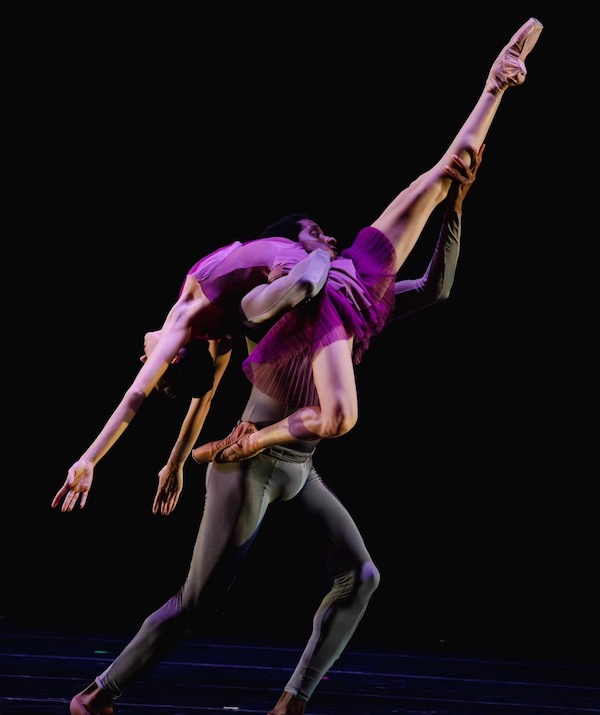Richmond Ballet lights up the summer sky with “Carmina Burana”

Richmond Ballet performed Ma Cong’s “Thrive” Wednesday night at Wolf Trap. Photo: Carolin Harvey
The Richmond Ballet finally made its maiden visit to Wolf Trap’s Filene Center on Wednesday night. The debut, delayed from the summer of 2020 by the pandemic, combined a new work celebrating the company’s future, Ma Cong’s Thrive, and a nod to its distinguished past in John Butler’s atavistic Carmina Burana. Conductor Erin Freeman led the Richmond Symphony and Chorus, as well as members of City Choir of Washington.
Ma Cong, appointed last year as associate artistic director of Richmond Ballet, said he was inspired to create Thrive, premiered in 2022, by collaborations with gay pride and Asian-American groups in Richmond. Set in seven tableaux to the bubbly, neo-romantic music of British composer Oliver Davis, the choreography alternated between meditative stasis and frantic activity.
Ten pairs of dancers combined for various ensemble numbers, with the lead duo, Sabrina Sabino and Jack Miller, standing out for their poignant pas de deux in the sixth tableau, featuring pleading violin solos from concertmaster Daisuke Yamamoto. The second movement centered on a small women’s chorus, stationed at the large stage’s corners and singing rather insipid, self-affirming words by Simon Littlefield (“doo doo doo doo, this is me, this is you”).
This performance was the first time that the ballet was heard with its score performed live. The fourth scene, with music sharpened by dissonance for some much-needed variety, went for comic relief with jaunty movements by a trio of dancers. Four women made a lovely evocation of Carmen in the fifth scene, with the score’s allusion to the “Habanera” from Bizet’s Carmen. Pastel costumes (designed by Monica Guerra) and candy-bright lighting (Trad A. Burns) added to the aura of optimism for the company’s future.
The innocence of Thrive proved a good balance for the troubling subliminal messages of Carl Orff’s Carmina Burana. Although it is usually performed in concert these days, Orff gave the work the subtitle of “scenic cantata.” He intended the piece to be given as it was premiered, by Oper Frankfurt in 1937, with dance, choreography, visual elements, and staging. Orff, who never joined the Nazi party, did collaborate with them, earlier providing music for the 1936 Olympics.
Richmond Ballet has extended the life of John Butler’s danced staging of Carmina Burana, which the late choreographer created for New York City Opera in 1959. (Richmond Ballet now holds the rights to all of Butler’s choreography.) After leaving the famous opening chorus unstaged, like an overture, Butler gave a nod to the origins of the often salacious texts Orff selected from a manuscript copied by scribes at the Bavarian monastery of Benediktbeuern.
Under a projected image of Fortune’s Wheel, dancers in black friar-like costumes processed to the music of “Fortune plango,” periodically kneeling in prayer, hands clasped. In the next movement, “Veris leta facies,” some of their robes were stripped away to reveal dancers in loincloths seemingly made of leaves, like Adam and Eve. Although there were no subtitles projected or in the program, the explicit movements of the dancers throughout the evening made clear the carnality of Orff’s music, which is often glossed over in concert performances.
Three singers, drawn from this year’s crop of young artists at Wolf Trap Opera Company, sang the solo parts, all costumed as monks like the first dancers. Tenor Lunga Eric Hallam, who has been outstanding all summer long, was a sensation on the hallucinatory part of the roasted swan. Esther Tonea added to her list of accomplishments on the sopranos solos, especially the orgasmic sighs of the “Dulcissime” cadenza. Baritone Daniel Rich had his finest moments in the floating falsetto roulades of “Dies, nox et omnia.”
Elements of courtly dance informed Butler’s choreography in the “In the Meadow” and “Court of Love” sections of the score. Eri Nishihara showed an elegant line in a flowing white dress in the solo parts, and some of the danced love scenes turned violent as men jealously challenged one another. As Fortune’s Wheel turned again, casting down the happy into misery, the whole company danced in movements reminiscent of the ballet’s opening, but this time to the reprise of the opening chorus, “O Fortuna.”
The woman at the center of the performance, both literally and figuratively, was conductor Erin Freeman, who coordinated live music from the Richmond Symphony and Chorus, the latter joined with members of City Choir of Washington. In a single evening she was combining her roles as resident conductor of Richmond Ballet, former director of Richmond Symphony Chorus, and since last season, the successor of Robert Shafer as artistic director of City Choir of Washington. She led both works with confidence and panache, visible in a spotlight to the large chorus, arranged along the sides of the house for surround-sound effect.
Before the curtain, Richmond Ballet’s artistic director, Stoner Winslett, and the Governor of Virginia, Glenn Youngkin, presented Richmond Ballet’s Lifetime Achievement Award for Dance to Carmen de Lavallade. The 92-year-old former ballerina was one of the principal dancers at the premiere of Butler’s Carmina Burana. De Lavallade has advised Richmond Ballet on realizing that work, as well as others created by the choreographer, whom she worked with extensively.
Wolf Trap’s Chamber Music at the Barns returns 7:30 p.m. November 3 and 4 with violinist Pinchas Zukerman and friends. wolftrap.org


